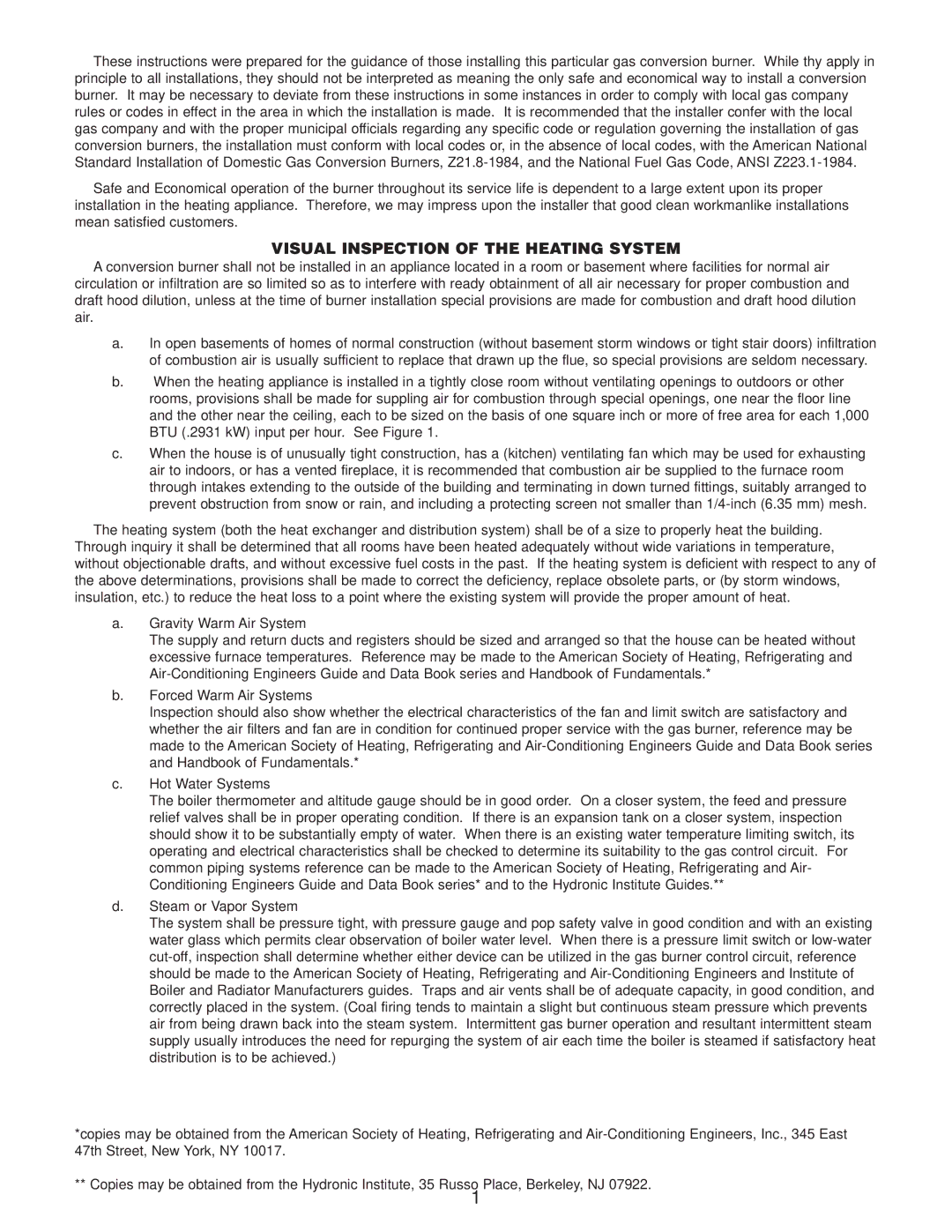These instructions were prepared for the guidance of those installing this particular gas conversion burner. While thy apply in principle to all installations, they should not be interpreted as meaning the only safe and economical way to install a conversion burner. It may be necessary to deviate from these instructions in some instances in order to comply with local gas company rules or codes in effect in the area in which the installation is made. It is recommended that the installer confer with the local gas company and with the proper municipal officials regarding any specific code or regulation governing the installation of gas conversion burners, the installation must conform with local codes or, in the absence of local codes, with the American National Standard Installation of Domestic Gas Conversion Burners, Z21.8-1984, and the National Fuel Gas Code, ANSI Z223.1-1984.
Safe and Economical operation of the burner throughout its service life is dependent to a large extent upon its proper installation in the heating appliance. Therefore, we may impress upon the installer that good clean workmanlike installations mean satisfied customers.
VISUAL INSPECTION OF THE HEATING SYSTEM
A conversion burner shall not be installed in an appliance located in a room or basement where facilities for normal air circulation or infiltration are so limited so as to interfere with ready obtainment of all air necessary for proper combustion and draft hood dilution, unless at the time of burner installation special provisions are made for combustion and draft hood dilution air.
a.In open basements of homes of normal construction (without basement storm windows or tight stair doors) infiltration of combustion air is usually sufficient to replace that drawn up the flue, so special provisions are seldom necessary.
b.When the heating appliance is installed in a tightly close room without ventilating openings to outdoors or other rooms, provisions shall be made for suppling air for combustion through special openings, one near the floor line and the other near the ceiling, each to be sized on the basis of one square inch or more of free area for each 1,000 BTU (.2931 kW) input per hour. See Figure 1.
c.When the house is of unusually tight construction, has a (kitchen) ventilating fan which may be used for exhausting air to indoors, or has a vented fireplace, it is recommended that combustion air be supplied to the furnace room through intakes extending to the outside of the building and terminating in down turned fittings, suitably arranged to prevent obstruction from snow or rain, and including a protecting screen not smaller than 1/4-inch (6.35 mm) mesh.
The heating system (both the heat exchanger and distribution system) shall be of a size to properly heat the building. Through inquiry it shall be determined that all rooms have been heated adequately without wide variations in temperature, without objectionable drafts, and without excessive fuel costs in the past. If the heating system is deficient with respect to any of the above determinations, provisions shall be made to correct the deficiency, replace obsolete parts, or (by storm windows, insulation, etc.) to reduce the heat loss to a point where the existing system will provide the proper amount of heat.
a.Gravity Warm Air System
The supply and return ducts and registers should be sized and arranged so that the house can be heated without excessive furnace temperatures. Reference may be made to the American Society of Heating, Refrigerating and Air-Conditioning Engineers Guide and Data Book series and Handbook of Fundamentals.*
b.Forced Warm Air Systems
Inspection should also show whether the electrical characteristics of the fan and limit switch are satisfactory and whether the air filters and fan are in condition for continued proper service with the gas burner, reference may be made to the American Society of Heating, Refrigerating and Air-Conditioning Engineers Guide and Data Book series and Handbook of Fundamentals.*
c.Hot Water Systems
The boiler thermometer and altitude gauge should be in good order. On a closer system, the feed and pressure relief valves shall be in proper operating condition. If there is an expansion tank on a closer system, inspection should show it to be substantially empty of water. When there is an existing water temperature limiting switch, its operating and electrical characteristics shall be checked to determine its suitability to the gas control circuit. For common piping systems reference can be made to the American Society of Heating, Refrigerating and Air- Conditioning Engineers Guide and Data Book series* and to the Hydronic Institute Guides.**
d.Steam or Vapor System
The system shall be pressure tight, with pressure gauge and pop safety valve in good condition and with an existing water glass which permits clear observation of boiler water level. When there is a pressure limit switch or low-water cut-off, inspection shall determine whether either device can be utilized in the gas burner control circuit, reference should be made to the American Society of Heating, Refrigerating and Air-Conditioning Engineers and Institute of Boiler and Radiator Manufacturers guides. Traps and air vents shall be of adequate capacity, in good condition, and correctly placed in the system. (Coal firing tends to maintain a slight but continuous steam pressure which prevents air from being drawn back into the steam system. Intermittent gas burner operation and resultant intermittent steam supply usually introduces the need for repurging the system of air each time the boiler is steamed if satisfactory heat distribution is to be achieved.)
*copies may be obtained from the American Society of Heating, Refrigerating and Air-Conditioning Engineers, Inc., 345 East 47th Street, New York, NY 10017.
** Copies may be obtained from the Hydronic Institute, 35 Russo Place, Berkeley, NJ 07922.
